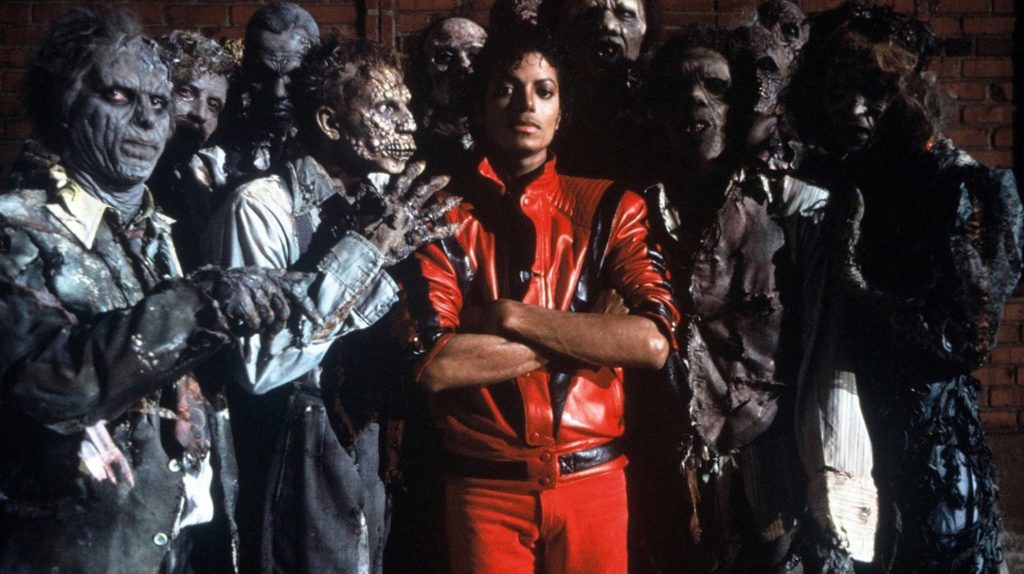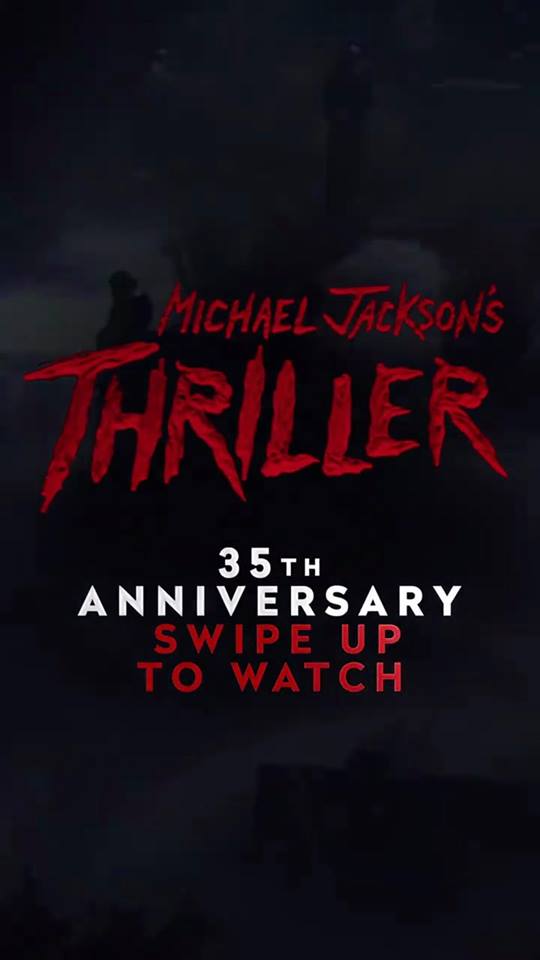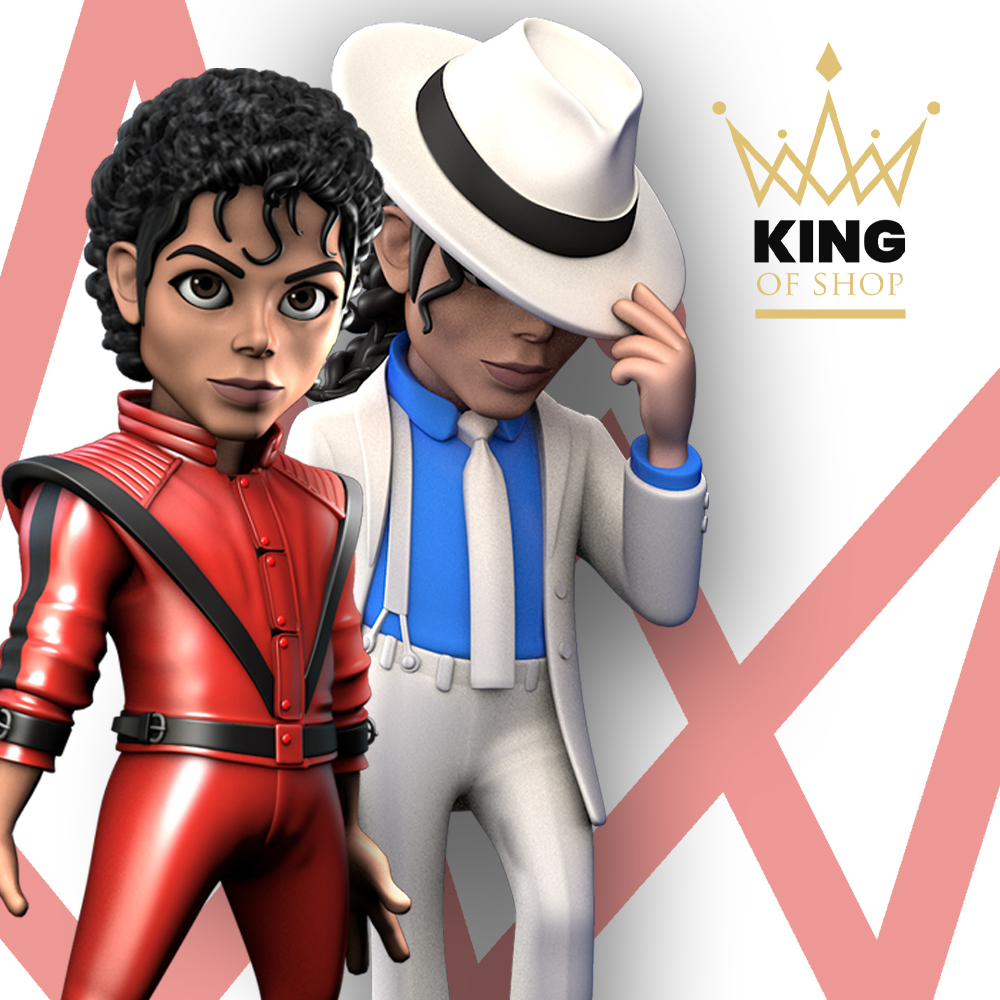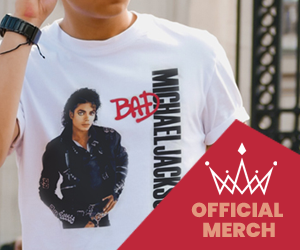
To Celebrate the 35th Anniversary of Michael Jackson’s THRILLER album, Sony and the Estate have launch a digital celebration of the biggest selling album of all time with an instagram’s link to the “Thriller” video on youtube.
Here what you could see on Instagram:

Last Sunday (Dec. 2) marks 35 years since the debut of Michael Jackson’s ground-breaking “Thriller” music video, which premiered on MTV and launched a dance craze, a red-jacket fashion favorite, and more pricey and ambitious videos by other top-tier artists.
The 14-minute “short film,” as the late singer preferred to call it, was shot on 35mm in downtown Los Angeles in the middle of the night. It was directed John Landis (National Lampoon’s Animal House, The Blues Brothers, An American Werewolf in London), and written by Landis and Jackson.
The title-track from Jackson’s 1982 album was written by Rod Temperton and produced by Quincy Jones, and became the seventh single after such hits as “Billie Jean” and “Beat It.” The landmark film went on to win three MTV Awards, two American Music Awards and a Grammy, and is the first and only music video to be inducted into the National Film Registry by the Library of Congress.
The 3D version of the music video and restored documentary Making Michael Jackson’s Thriller, directed by Jerry Kramer, premiered at the Venice Film Festival in 2017. This September, it became the first music video released in IMAX 3D. The song re-entered the Hot 100 on Nov. 10, 2018 at No. 31, the highest it has been since April 7, 1984.
Billboard spoke with John Landis, and entertainment lawyer John Branca, who brokered the deal with MTV and Showtime and is now co-executor of Michael Jackson’s Estate, about getting the $1 million to make the music video, its impact on the business, stealing the tracks from Quincy Jones without his knowledge and more.
That was pretty ballsy to go to a television station to try and cover the costs of making a music video.
John Branca: At the time, most music videos cost about $50,000 [to make], and Michael and John Landis had a budget of $1.2 [million] for this project, and the record company refused to pay for it, for good reason [laughs]. So I said to Michael, “You know, it’s a million two?” and he basically said, “Branca, figure it out.” So I came up with the idea for a “making of,” a long-form, 60-minute piece. It was the first time MTV ever paid for a video, and Showtime paid for it, their sister station, and then we put it out with Vestron [Video] and we actually ended up making a profit.
What do you remember about the time on set and the amazing masks and prosthetics?
Branca: At that time, I was Michael’s main business advisor/manager and so I really focused on the business. Now, when running the estate, I have to do the creative also, but at that time Michael and Landis did all the creative. The one thing that I did do — because growing up as a boy, I loved monster movies, so Werewolf, Lon Chaney, Dracula, Bela Lugosi, Boris Karloff, Frankenstein — when Michael felt pressure from the church, from Jehovah’s Witnesses, he told me to get the film canisters and destroy them, before the “Thriller” video was ever released. So I held them in my office for many, many days and he would call everyday.
To destroy the whole thing?
Branca: Yes. So the world would never have seen it. Finally I said to him, “You know Michael, Bela Lugosi played Dracula” — I kinda made it up, I said, “He was very religious.”
He wasn’t religious?
Branca: No. Who knows? So I said, “We’ll put a disclaimer on it.” That’s why you’ll see the disclaimer [at the start of the music video] that due to his personal convictions it doesn’t reflect Michael’s personal views.
John, Michael called you because he was a fan of your film An American Werewolf In London?
John Landis: Everything in Making Michael Jackson’s Thriller is accurate.
Good thing he wasn’t a fan of Animal House or we’d be having a much different conversation.
Landis: He wanted to turn into a monster, and the first discussion with [special effects make-up creator] Rick Baker, he wanted to turn into the werewolf from An American Werewolf in London, and it took me a while to talk him out of it because I was saying it’d be really hard to dance with four legs, you know. That’s why he became that Werecat thing, because I suggested the werewolf from I Was a Teenage Werewolf, [starring] Michael Landon, in the letterman’s jacket. Rick’s first design, which was great, was too ugly. I said, “Look, it’s Michael. He can’t be ugly.” I think what he made was very elegant, that sort of cat creature.
Branca: It’s scary, though.
Landis: Oh, it’s scary. It’s meant to be scary.
Right from the start you weren’t interested in making a music video. You wanted it to be elaborate.
Landis: Music videos at that time were always just needle drop. Some were pretty good, but most were not, and they were commercials. Michael’s such a huge star that I said, “Maybe I can bring back the theatrical short.” I pitched him the idea, and he totally went for it. Michael was extremely enthusiastic because he wanted to make movies.
Branca: He came to refer to his music videos as short films, and he instructed everybody, “These are not music videos; these are short films.”
What did you both notice after “Thriller” came out? Record companies probably weren’t very “thrilled” with you because all the other big artists probably wanted to make million dollar videos.
Landis: Absolutely the opposite.
Branca: They were thrilled, actually.
Landis: You have to remember, nobody wanted it. We had to figure out a way to finance it because it was a union shoot in Los Angeles. I demanded the dancers had at least a week’s rehearsal, all that make-up, so it was expensive. CBS Records basically said, “[The album has] been No. 1 for over a year. We made ‘Billie Jean’ and ‘Beat It,’ with [directors] Steve Barron and Bob Giraldi [respectively] — hugely influential important videos, which cost very little, and you’re coming to us? You already have the most successful album of all time, and now you want to do this vanity video so you can turn him into a monster? Go f–k yourselves,” was essentially what they said it to me. They didn’t say it to Michael, but that was the same thing. So we had to figure out a way to make it, which is why Making Michael Jackson’s Thriller was done, so we’d have an hour and we could sell the hour. Do you know what happened when the video “Thriller” came out on TV? The No. 1 selling album in the world, already out for a year, tripled its sales. So everybody jumped on the bandwagon.
Branca: It changed the way people make music videos.
Landis: It raised the standard. Everybody became much more ambitious, and tons of big directors came out of music videos.
Branca: “Thriller” remains the most influential and most important video of all time. Everybody’s acknowledged it, so kudos to John.
Landis: It’s always called those things and I don’t make those claims, but it certainly had a huge impact not only on the music business — and it made MTV. Their viewership went nuts.
As a filmmaker and someone who’s just had the sound quality and visual presentation of the “Thriller” video upped [in 3D and Dolby Atmos], how does it make you feel that people today watch videos on YouTube, on computer and phone screens?
Landis: I’m not crazy about it.
Branca: You should talk about the sound.
Landis: The sound. Okay. “Thriller” was just stereo, left and right. The soundtrack for Thriller, I said, “This is a movie; this is not a rock video.” Rock videos are always needle drop. A record at that time was mixed to sound good on your car radio, so, I said, “This is a movie.” So I asked Quincy Jones and Bruce Swedien, “Can I have the tracks to ‘Thriller’?” They both said no. I explained to Michael we needed them. So George Folsey and I and Michael, at like 2 in the morning, went to the recording studio, walked in the lobby, the guard, said, “Hello Mr. Jackson.” “Hello.” We went in the back, found the tracks on the racks, took all of them — there were a lot — put them in two big duffel bags, put them in the trunk in a car, drove them over the hill [to the engineer], where they [duplicated] them all. We put them back in the duffel bags, went back with Michael over the hill, and put them back [laughs]. I’ve always been amazed that Bruce Swedien and Quincy have never said anything because “Thriller” is very different than the record. I only used a third of the lyrics. It’s a 3-minute song; in the film, it plays for 11 minutes. Well now, through new technology called Atmos, you can put sound anywhere in the house. It’s amazing: I had to relearn that because music is always left-right-center, and suddenly how the f–k do you mix this because its everywhere. But we were able to bring it up and it’s astounding.
That story should have been in the documentary.
Landis: I discussed it with Quincy. Do you know that they didn’t notice? And Quincy was at the premiere [of the 3D version] and I said, “What did you think? “I loved it. It was great,” and everything and I just thought to myself, “You motherf–ker, you said ‘No,’ you bastard.” [laughs]
Branca: Quincy said you’re not allowed to remix his tracks ever without his permission, so be careful.
Landis: Too late.
SOURCE: Billboard




The story of them sneeking into the studio to ‘borrow’ the tracks is a total hoot. Love it.